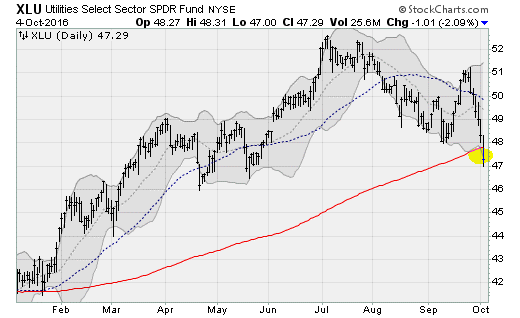Suddenly, "safe havens" are looking risky
U.S. equities dribbled lower again on Tuesday, but that wasn’t the big news.
The most important development was a continuation of very intense selling that has roiled some of the most conservative, defensive areas of the market -- those that have been long considered “safe havens” for investors seeking a quiet harbor amid the day-to-day tumult. These areas are where investors’ focus is normally on smooth, steady dividend income instead of flash-in-the-pan momentum gains.
The list of casualties include gold and silver, precious metals stocks, Treasury bonds, investment-grade corporate bonds and yield-sensitive stocks in areas like utilities, telecoms and real estate. Let’s take a look at the carnage and at some of the reasons behind it.
Gold futures lost 3.3 percent in what was the worst one-day loss since 2013. The Market Vectors Gold Miners (GDX) fell nearly 10 percent to return to levels not seen since early June. Treasury bonds dropped, pushing the 30-year yield to 2.4 percent, up from a low of 2.1 percent in July. The Utilities Select SPDR (XLU) is now down for eight consecutive sessions for a total loss of 7.3 percent -- enough to wipe out more than two years of dividend income.
You get the idea.
Two catalysts are fueling these moves: A surge of strength in the U.S. dollar (which is pounding precious metals) and weakness in the long-term government bond market (which is punishing yield-sensitive stocks like utilities).
The dollar’s rise resulted from the reappearance of worries about Brexit, the U.K.’s intention to leave the European Union. The pound sterling fell near a 31-year low on mounting evidence U.K. Prime Minister Theresa May is moving forward with a clean break from the EU sometime in 2017 with an interim deal being dismissed and protections for Britain’s financial sector being refused.
Some hawkish commentary from the Federal Reserve helped as well, boosting the odds of a December interest rate hike. Richmond Fed President Jeffrey Lacker said the central bank needs to be more preemptive in raising rates to keep the institution from falling behind the curve on inflation pressure -- which would necessitate even more aggressive rate hikes.
He added that employment and inflation are running at or very close to mandate-consistent levels and that history suggests the Fed’s benchmark interest rate should be at 1.5 percent or more by now vs. just 0.5 percent currently.
The weakness in bonds pushed up long-term interest rates, something that rattled markets a few weeks ago on reports the Bank of Japan was considering lessening its support to the long-term bonds market. Those reports were eventually confirmed by policymakers.
Turning to the European Central Bank, a Bloomberg report said the bank may begin tapering its bond-buying program before it ends in March 2017. This would follow the pattern the Fed set when it tapered its QE3 program before ending it in December 2014.
While this was subsequently denied by the ECB, which claimed such a move hasn’t even been discussed, it shocked many traders who have been penciling in an extension of the ECB’s bond buying further into 2017 or beyond.
What both the BoJ and the ECB news have in common -- along with the Fed rate hike chatter -- is that central bank support of long-term bonds could soon be ending or at least start being scaled back. No wonder long-term interest rates are getting pushed higher.
And it reveals that “safe,” income-focused stocks and bonds are anything but in a rising rate environment because prices need to fall to push dividend yields up in sympathy with rates.

